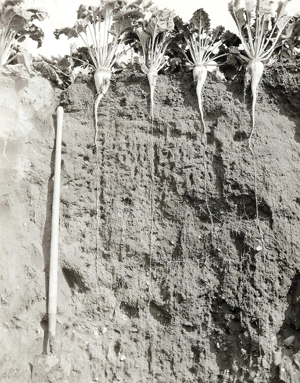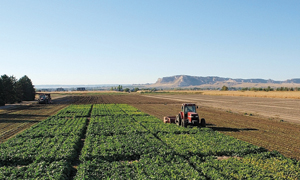G1459
Sugarbeet Nutrient Management
Fertilizer management is a key component in maximizing sucrose yield. Management practices that maximize tonnage and sucrose content while minimizing impurities are key to achieving top yields of high quality sugarbeet in the High Plains.
Gary W. Hergert, Nutrient Management and Soil Quality Specialist
- Soil Sampling and Testing
- Nitrogen
- Phosphorus
- Starter Fertilizer and Pop-up Fertilizer
- Potassium
- Sulfur
- Zinc
- Other Nutrients
|
Soil Sampling and Testing
Soil testing is essential for sugarbeet nutrient management. The goal is to determine the amount of nutrients in the soil and develop a fertilizer program for optimal crop nutrition prior to planting.
Surface soil samples from a depth of 0 to 8 inches are taken to determine pH, salinity, organic matter, phosphorus, potassium, nitrate-N, and micronutrients. Deeper samples used to test for residual nitrate-N are important because the sugarbeet’s extensive taproot system is effective in deep nitrate-N uptake (Figure 1). Past guidelines recommended sampling to a 6 foot depth, but a 4-foot depth has become accepted practice. Soil sampling guidelines can be found at http://www.ianrpubs.unl.edu/sendIt/g1740.pdf and http://www.ianrpubs.unl.edu/sendIt/ec154.pdf.
Nitrogen
Proper nitrogen (N) management is critical for optimal sugarbeet production. Applying too little will result in reduced root tonnage, while applying too much will result in reduced sucrose concentrations and increased impurities (Figure 2). Nitrogen fertilizer recommendations are based on residual nitrate in the soil, soil organic matter, previous crop, amounts of manure applied 12 to 24 months previously, and amounts of nitrogen in irrigation water.
 |
 |
|
| Figure 1. The long root system of sugarbeet allows plants to utilize nitrate-nitrogen from depths of 5 feet or more. | Figure 2. Inadequate amounts of nitrogen (beet on left) affect growth and sucrose concentration in sugarbeet. |
Sugarbeets have an effective rooting depth of 6 feet. For practical soil sampling considerations, we are revising our nitrogen recommendation algorithm and changing the soil nitrate-N test to a 4-foot basis. Expected yield normally should not exceed the average yield of the last three to four sugarbeet crops by more than five percent. Fertilizer nitrogen recommendations can be calculated using the following equation:
Nitrogen Need (lb N/ac) =
(8 x EY) – (30 x OM) – RSN4ft – Other Credits
where:
EY = expected yield (tons/ac)
OM = organic matter percent
RSN4ft = residual soil nitrogen measured to a 4 foot depth (lb N/ac)
Other Credits = N mineralization from organic, legume, or crop reside sources or nitrate-N in irrigation water
An example for three different yield goals is given in Table I.
| Table I. Suggested nitrogen fertilizer rates for three yield levels at 1.5 percent soil organic matter. | |||
Lb NO3-N in 4 feet |
Sugarbeet Yield Goal |
||
24 tons |
28 tons |
32 tons |
|
------ pounds of nitrogen per acre to apply ------ |
|||
25 |
125 |
155 |
185 |
50 |
100 |
130 |
160 |
75 |
70 |
105 |
135 |
100 |
50 |
80 |
110 |
125 |
20 |
55 |
90 |
All nitrogen fertilizer sources {urea (46-0-0), urea-ammonium (28-0-0 or 32-0-0), ammonium sulfate (21-0-0) and anhydrous ammonia (82-0-0)} are effective, but vary in susceptibility to volatilization of ammonia. Incorporating soon after applying nitrogen fertilizer (light tillage or 0.5 inch of sprinkler irrigation) is effective in minimizing volatilization of ammonia.
Shallow incorporation of a high rate of spring preplant urea-N can have a detrimental effect on stand establishment. Spring application of 100 pounds of nitrogen per acre from urea reduced stands by more than 6,000 plants per acre compared to no nitrogen. Under gravity irrigation, it is advisable to apply nitrogen fertilizers and incorporate with plowing or disking before planting or sidedress between the two to six true leaf growth stages. Another option is to apply nitrogen using strip-tillage application. Nitrogen application with sprinkler irrigation is also a very efficient method and has no effect on stand due to nitrogen dilution with irrigation water.
|
||||||||||
Manure application is not recommended for sugarbeet production. Use manure on other crops in the rotation, especially corn. Much of the nitrogen from manure is released in the latter part of the growing season and tends to retard sugar accumulation and increase impurities. Nitrogen credits for plowed-down alfalfa are given in Table II.
Recent research with composted manure showed minimal detrimental effects on quality due to slower nitrogen mineralization than with non-composted manure. The composted manure contained 15 to 20 pounds of nitrogen per ton and provided an apparent nitrogen release of about 10 pounds per ton during the growing season. Composted manure in western Nebraska currently costs $15-$18/ton. About 12 tons of composted manure may be needed but would cost much more than an optimum rate of inorganic nitrogen. The additional phosphorus, sulfur, carbon, and micronutrients from manure could benefit sugarbeet and following crops, but the economics must be considered. The highest rate of compost (16 tons/acre) did not significantly reduce stand, sugar, or tonnage or increase impurities. If there ever is a major fertilizer shortage, composted manure could be substituted for mineral fertilizer and produce acceptable yields, quality, and sugar.
Phosphorus
Phosphorus (P) is the second most limiting nutrient in sugarbeet production. Leaves of plants deficient in phosphorus appear darker green than plants with adequate phosphorus. With increasing phosphorus deficiency, plant growth will be stunted. Phosphorus deficiency is usually associated with soils that are high in pH and low in organic matter (eroded knolls and areas of land leveling). Soils that require phosphorus fertilization can be identified by soil testing.
Different soil extractants are now being used by commercial soil testing laboratories to determine available phosphorus. Most research has been conducted on calibrating Bray-1 P with yield response. The following equations can be used to convert other extractants to a “Bray-1 P equivalent”
For Mehlich 2: Bray-1 = 0.9 x Mehlich 2
For Mehlich 3: Bray-1 = 0.85 x Mehlich 3
For Olsen P: Bray-1 = 1.5 x Olsen P
Research indicates that yield increases are expected from phosphorus applications when soil test levels are below 15 ppm by the Bray-1 method or equivalent conversion of other tests. As average sugarbeet yields continue to increase, there is a good probability of yield increase from phosphorus fertilization when soil tests are equal to 20 ppm Bray-1 P or below. Yield increases are unlikely if soil tests are greater than 20-25 ppm Bray-1 P. Use of starter phosphorus will help maintain soil phosphorus, and other nutrients may be applied in the starter fertilizer.
Phosphorus recommendations are given as an equation rather than in table form to more accurately accommodate computer controlled and GPS guided variable rate applications. The following equation for phosphorus recommendations is suggested for sugarbeets:
P rate (pounds per acre) = 5 x (24 – Bray P1 test value)
This equation provides values similar to older tabular (stairstep) values, is more comparable to other High Plain (Colorado, Wyoming, Montana) sugarbeet phosphorus recommendations, and gives a better approximation of fertilizer needs over a wide range of soil test levels.
Starter Fertilizer and Pop-up Fertilizer
|
||||||||||||||
Band application at planting (starter fertilizer) is the most efficient placement method for phosphorus fertilizers. If the phosphorus fertilizer is band-applied, phosphorus rates can be reduced by 50 percent compared with the phosphorus equation and Table III. Pop-up placement (directly with the seed) for sugarbeets is not recommended because seedling emergence may be slowed and stand reduced due to salt effects, especially in dry soil. Research completed in 2011 at Scottsbluff did not show a yield enhancement regardless of soil test phosphorus level, and in two out of three years, there was significant stand loss at pop-up rates above three gallons per acre of 10-34-0. If pop-up rates are above three gallons per acre, it is recommended to dilute starter fertilizer 50-50 with water.
Monoammonium phosphate (MAP, 11-52-0), diammonium phosphate (DAP, 18-46-0), and ammonium polyphosphate (10-34-0) are equally effective per unit of phosphorus if properly applied. Choose fertilizer based on product and equipment availability and cost per unit of phosphorus.
Potassium
Most soils where sugarbeets are grown in Nebraska have much higher potassium soil test levels than needed for optimal sugarbeet production. If soil tests show a deficiency, potassium fertilizer recommendations are given in Table IV.
Sulfur
The likelihood of obtaining a response to sulfur fertilizers on sugarbeets in Nebraska is small. Irrigation water should be tested for sulfate content and if it is above 6 ppm, no sulfur would be required. If sugarbeets are grown on sandy soils with less than 1 percent organic matter, and irrigation water levels of sulfate are less than 6 ppm, 10 lb of sulfur per acre may be applied.
Zinc
A response to zinc fertilizers in sugarbeets should not be expected unless the DTPA soil test level is less than 0.5 ppm. Research has shown that even below this level the likelihood of a zinc response is low. If the DTPA zinc soil test level is less than 0.5 ppm, apply 1 lb of zinc per acre in a band or 5 lb of zinc per acre broadcast.
Other Nutrients
The likelihood of obtaining a response in sugarbeets to the application of fertilizers containing calcium, magnesium, iron, manganese, copper, molybdenum, boron, or chlorine is extremely unlikely in Nebraska soils.
| Table IV. Potassium fertilizer suggestions. | ||
Potassium soil test level (ppm K) |
Relative Level |
Amount of K2O (lb/acre) |
0 - 40 |
very low |
120 |
41 - 74 |
low |
80 |
75 - 124 |
marginal |
40 |
> 124 |
adequate |
0 |
This publication has been peer reviewed.
Visit the University of Nebraska–Lincoln Extension Publications website for more publications.
Index: field Crops
Miscellaneous Crops
2002, Revised November 2012
